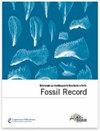下载PDF
{"title":"模拟鸟类胃磨机及其对胃石化石真实性的影响","authors":"Oliver Wings","doi":"10.1002/mmng.200800013","DOIUrl":null,"url":null,"abstract":"<p>A rock tumbler, stones, water, plant material, hydrochloric acid, and pepsin were used to simulate a bird gizzard in order to study abrasion rate and influence of stomach juices and foodstuff on gastrolith surface development. The experiment lasted for six months. Each week, the “stomach” was supplied with fresh grass and stomach juices. After the end of the experiment, the set of stones had a combined weight loss of 22.4 %, with softer rock types showing higher abrasion rates. The combination of stomach juices and silica phytoliths within the grass had no visible effect on stone surface development: polish or pitting did not occur. A second experiment combined only pebbles with water in the tumbler. Results indicate that rock abrasion is mainly caused by contacts between moving stones. A comparison with authentic ostrich gastroliths showed that abrasion in the artificial stomach must have been lower than in a real gizzard, but still too high to maintain or develop surface polish. If high polish occasionally seen on sauropodomorph dinosaur gastroliths was indeed caused in a stomach environment, it implies digestive processes different from those of extant birds and the “artificial gizzard”. Geologic origins of polish, such as transport in hyperconcentrated flows, wind blasting, or tectonic movements must be considered for polished fossil gastroliths and isolated clasts in fine-grained sediments (exoliths). (© 2009 WILEY-VCH Verlag GmbH & Co. KGaA, Weinheim)</p>","PeriodicalId":55147,"journal":{"name":"Fossil Record","volume":"12 1","pages":"91-97"},"PeriodicalIF":2.1000,"publicationDate":"2009-02-20","publicationTypes":"Journal Article","fieldsOfStudy":null,"isOpenAccess":false,"openAccessPdf":"https://sci-hub-pdf.com/10.1002/mmng.200800013","citationCount":"7","resultStr":"{\"title\":\"A simulated bird gastric mill and its implications for fossil gastrolith authenticity\",\"authors\":\"Oliver Wings\",\"doi\":\"10.1002/mmng.200800013\",\"DOIUrl\":null,\"url\":null,\"abstract\":\"<p>A rock tumbler, stones, water, plant material, hydrochloric acid, and pepsin were used to simulate a bird gizzard in order to study abrasion rate and influence of stomach juices and foodstuff on gastrolith surface development. The experiment lasted for six months. Each week, the “stomach” was supplied with fresh grass and stomach juices. After the end of the experiment, the set of stones had a combined weight loss of 22.4 %, with softer rock types showing higher abrasion rates. The combination of stomach juices and silica phytoliths within the grass had no visible effect on stone surface development: polish or pitting did not occur. A second experiment combined only pebbles with water in the tumbler. Results indicate that rock abrasion is mainly caused by contacts between moving stones. A comparison with authentic ostrich gastroliths showed that abrasion in the artificial stomach must have been lower than in a real gizzard, but still too high to maintain or develop surface polish. If high polish occasionally seen on sauropodomorph dinosaur gastroliths was indeed caused in a stomach environment, it implies digestive processes different from those of extant birds and the “artificial gizzard”. Geologic origins of polish, such as transport in hyperconcentrated flows, wind blasting, or tectonic movements must be considered for polished fossil gastroliths and isolated clasts in fine-grained sediments (exoliths). (© 2009 WILEY-VCH Verlag GmbH & Co. KGaA, Weinheim)</p>\",\"PeriodicalId\":55147,\"journal\":{\"name\":\"Fossil Record\",\"volume\":\"12 1\",\"pages\":\"91-97\"},\"PeriodicalIF\":2.1000,\"publicationDate\":\"2009-02-20\",\"publicationTypes\":\"Journal Article\",\"fieldsOfStudy\":null,\"isOpenAccess\":false,\"openAccessPdf\":\"https://sci-hub-pdf.com/10.1002/mmng.200800013\",\"citationCount\":\"7\",\"resultStr\":null,\"platform\":\"Semanticscholar\",\"paperid\":null,\"PeriodicalName\":\"Fossil Record\",\"FirstCategoryId\":\"89\",\"ListUrlMain\":\"https://onlinelibrary.wiley.com/doi/10.1002/mmng.200800013\",\"RegionNum\":4,\"RegionCategory\":\"地球科学\",\"ArticlePicture\":[],\"TitleCN\":null,\"AbstractTextCN\":null,\"PMCID\":null,\"EPubDate\":\"\",\"PubModel\":\"\",\"JCR\":\"Q3\",\"JCRName\":\"Earth and Planetary Sciences\",\"Score\":null,\"Total\":0}","platform":"Semanticscholar","paperid":null,"PeriodicalName":"Fossil Record","FirstCategoryId":"89","ListUrlMain":"https://onlinelibrary.wiley.com/doi/10.1002/mmng.200800013","RegionNum":4,"RegionCategory":"地球科学","ArticlePicture":[],"TitleCN":null,"AbstractTextCN":null,"PMCID":null,"EPubDate":"","PubModel":"","JCR":"Q3","JCRName":"Earth and Planetary Sciences","Score":null,"Total":0}
引用次数: 7
引用
批量引用

 求助内容:
求助内容: 应助结果提醒方式:
应助结果提醒方式:


